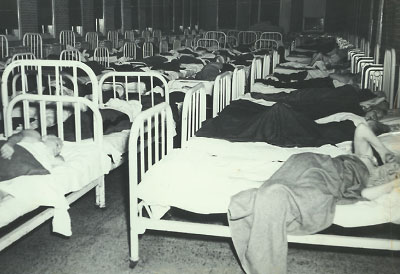The Rise and Demise of America’s Psychiatric Hospitals: a Tale of Dollars Trumping Sense
Abstract
In numerous public institutions, especially in the 1950s, the sleeping arrangements for patients with mental illness or mental retardation lacked any semblance of privacy or dignity. The above photo is from the June 1961 issue of APA’s journal Mental Hospitals, now Psychiatric Services.
The 20th century contains dramatic changes in the roles played by psychiatric hospitals. From 1900 to 1955, the peak year-end census in state and county hospitals, public psychiatric hospitals were provided minimal resources to meet the needs of huge patient populations. Subsequently, as these hospitals were progressively eviscerated, the hospitals and those who worked there were vilified, perhaps as a way to assuage the guilt of what happened to their former residents. The asylums of earlier days became popularly known as the snake pits of the 1940s and 1950s and abandoned shells in our lifetimes. How did this happen?

In numerous public institutions, especially in the 1950s, the sleeping arrangements for patients with mental illness or mental retardation lacked any semblance of privacy or dignity. The above photo is from the June 1961 issue of APA’s journal Mental Hospitals, now Psychiatric Services.
In 1955, 50 percent of all hospital beds in the United States were psychiatric beds, a fact made infamous by Mike Gorman in his book, Every Other Bed. The rise in census did not occur because “nobody ever got discharged from a state hospital” between 1900 and 1955, but rather because public hospitals admitted more patients than they discharged for many years. For example, in Fiscal Year 1925 Worcester State Hospital (WSH) started with a census of 2,523 patients (almost exactly 50 percent of each sex), admitted 643 patients, discharged 427 patients, and ended the year with 2,739 patients. Over a decade, following this pattern, a hospital’s census could increase by 2,000 patients.
The ever-increasing population of public psychiatric hospitals from 1900 to 1955 was largely due to these facilities’ becoming the destination for those with syphilis and for the elderly. The change from an agrarian to an industrial society meant the large multigenerational family was dissolving. This change left no one to take care of elderly family members, who, unfortunately, then became the responsibility of the state. For example, there were 183 deaths at WSH in Fiscal Year 1925; thus, 43 percent of the discharges were through death. One might say this was indicative of fairly poor medical care, but 47 percent of those who had died were aged 65 years and older (males 66 percent, females 34 percent). The principal diagnoses among those who had died were, in descending order, senility (33 percent), dementia praecox (14 percent), and syphilis (14 percent). Of the 18 patients who died from alcoholism, 75 percent were aged 65 years and older. Individuals were sent to the state hospital in the last stages of life: 16 percent were at WSH less than one month, and 13 percent one to three months; thus, 29 percent died within three months of admission.
Public hospitals became overwhelmed by the sheer numbers of patients. In the 1950s, there were only 26 U.S. cities whose population exceeded the aggregate population of public psychiatric institutions. The two largest hospitals each had a census that exceeded 16,000 patients. Never able to keep up with the needs of their patients, the hospitals went from awful to appalling when their workforce—from the farmer to the doctor—was pulled away to meet the manpower demands of World War II. The population at large learned of the horrors of their public psychiatric hospitals, tragedies long hidden away, through exposés such as The Snake Pit, Mary Jane Ward’s fictionalized account of her hospitalization at Rockland State Hospital (book, 1946; movie 1948); author Albert Q. Maisel’s article in Life magazine (1946) accompanied by some of the most painful pictures the American public had ever seen from Pennsylvania’s Byberry and Ohio’s Cleveland state hospitals; and The Shame of the States (1948), New York Post reporter Albert Deutsch’s opus based on research from 1944 to 1947.

President John F. Kennedy signs the Community Mental Health Act into law on October 31, 1963.
Perhaps the most dramatic shift in the use of psychiatric hospitals, and the most misunderstood, is “deinstitutionalization.” First, deinstitutionalization was not a thought-out policy shift, not a movement, and not even labeled until considerably after the relocation of psychiatric patients from hospitals to settings outside of hospitals had begun. The depopulation of America’s public hospitals occurred due to a confluence of factors including exposés and reports by conscientious objectors working in these hospitals in lieu of combat in World War II, the introduction of chlorpromazine (1954), a new breed of activist attor neys, and the naissance of the disability rights movement.
On October 31, 1963, President John F. Kennedy signed what would turn out to be his last major bill, the Community Mental Health Centers Act. While Kennedy was extolled for this legislation, the bill turned out to be not much more than a hiccup, and Kennedy actually had little interest in it.
None of these factors, however, was as important as the passage of Medicaid. States realized that through Medicaid they could shift significant percentages of their expenditures for people with serious mental illness to the federal government by moving them out of large institutions and into facilities of 16 or fewer beds due to payment limitations imposed by the Institution for Mental Disease (IMD) exclusion. The states had been impatiently waiting for federal participation in funding the care of people with serious mental illness since 1854, when President Franklin Pierce vetoed a bill that would have made the federal government responsible for those who were poor and had a mental illness. The slope charting the rate of depopulation of the public hospitals became steeper after the passage of Medicaid. The cost-shifting race was on.

Jeffrey Geller, M.D., M.P.H., is a professor of psychiatry at the University of Massachusetts Medical School and a member of the APA Foundation Library and Archives Advisory Committee. Geller will become president-elect of APA at the end of APA’s 2019 Annual Meeting.
Whether deinstitutionalization has ever occurred remains a matter of debate. While the number of current public hospital psychiatric beds represents about 3 percent of the 1955 peak, people with serious mental illness are found in many locations providing 24-hour care, including nursing homes, jails, prisons, general hospital psychiatric units, private psychiatric hospitals, contracted intermediate and long-term care psychiatric facilities, community residences (including some with locked doors and some where a person who leaves is shadowed by staff), crisis beds (often locked), and respite beds. Some who live “free” in the community are under the supervision of mental health courts or experience Assertive Community Treatment teams as unduly interfering in their lives or feel intensive case managers run their lives. Counted among those who may be totally unfettered by the mental health system are shelter residents and the homeless. This has led the critics of deinstitutionalization to instead label it “transinstitutionalization.”
Over the past 60 years, many with serious mental illness have led and are leading self-directed, highly productive, meaningful, and satisfying lives. Many are not. The sad part of the history of public psychiatric hospitals over the past 118 years is that very few in government really cared how they could best be used. Of greater importance has been how much will any service for a person with serious mental illness cost and how can we get someone else to pay for it. ■



